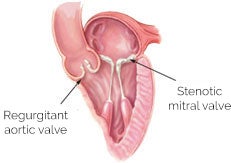
Heart Basics
Causes and effects of heart valve disease
Heart valve disease occurs when one or more of the valves is damaged.
Causes:
- Degenerative valve disease — This is a common cause of valvular degeneration. Most commonly affecting the mitral valve, it is a progressive process that represents slow degeneration from mitral valve prolapse (improper leaflet movement), a condition that affects 4-5 percent of the general population. Over time, the attachments of the valve thin out or rupture and the leaflets become floppy and redundant. This leads to leakage through the valve.
- Calcification due to aging — Calcification is the process that refers to the accumulation of calcium on the heart’s valves. The aortic valve is the most frequently affected. This build-up hardens and thickens the valve and can cause aortic stenosis, or narrowing of the aortic valve. As a result, the valve cannot open completely as the valve function is limited and blood flow is hindered. This blockage forces the heart to work harder causing limited physical capacities. Calcification comes with age as the calcium amasses in the heart over the course of a lifetime.
- Coronary artery disease — Coronary artery disease affects the blood flow between the heart and its systems due to an accumulation of plaque in the arteries. This build up causes hardening of the coronary arteries also known as atherosclerosis and restricts maximum blood flow to the heart muscle. Without an ample supply of oxygen-rich blood, the heart suffers. This may be evidenced by chest pain or shortness of breath in the patient. If the arteries become completely blocked, the blood will not flow and will clot, leading to a heart attack. If a patient is exhibiting symptoms of coronary artery disease, a physician will run a series of tests including, but not limited to, an electrocardiogram or EKG/ECG, cardiac catheterization, blood work, and/or chest x-ray.
- Rheumatic fever — Rheumatic fever is caused by an infection of the Group A Streptococcus bacteria and can detrimentally affect the heart and cardiovascular system, especially the leaflet tissue of the valves. Rheumatic fever is most common in children ages 5 – 15, but can develop in adults. Rheumatic heart disease is common in developing countries.
- Congenital abnormalities — Generally, congenital heart defects affect the flow of blood through the cardiovascular system. Blood can flow in the wrong direction, in abnormal patterns, and can even be blocked, partially or completely, depending on the type of heart defect present. Ranging from mild defects such as a malformed valve to the more severe such as an absent heart valve, congenital heart abnormalities require different treatments. In some cases, medicine can be used to treat the condition; in others, surgery may be necessary.
- Bacterial endocarditis — Bacterial endocarditis is a bacterial infection that can affect the valves of the heart causing deformity and damage to the leaflets of the valve(s).
Effects:
- Regurgitation occurs when blood flows back into the valve as the leaflets close or leaks through the leaflets after they are closed. This condition causes the heart to work harder to pump the same amount of blood.

A leaky (regurgitant) mitral valve allows blood to flow back from the ventricle to the left atrium when the ventricle contracts

A leaky (regurgitant) aortic valve allows blood to flow back from the aorta to the left ventricle when the ventricle relaxes
- Stenosis is the narrowing of a valve opening that causes lower blood flow through the valve. This in turn increases the risk of blood clots and causes the heart to work harder.

A narrowed (stenotic) mitral valve restricts blood flow from the left atrium to the left ventricle

A narrowed (stenotic) aortic valve reduces efficient blood flow from the left ventricle to the aorta